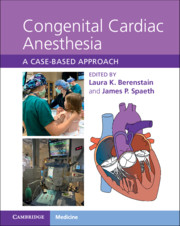Book contents
- Congenital Cardiac Anesthesia
- Congenital Cardiac Anesthesia
- Copyright page
- Dedication
- Contents
- Contributors
- Introduction
- Chapter 1 A Congenital Heart Disease Primer
- Section 1 Left-to-Right Shunts
- Chapter 2 Ventricular Septal Defect
- Chapter 3 Double-Outlet Right Ventricle
- Chapter 4 Transitional Atrioventricular Septal Defect
- Chapter 5 Unbalanced Atrioventricular Septal Defect
- Section 2 Right-Sided Obstructive Lesions
- Section 3 Left-Sided Obstructive Lesions
- Section 4 Complex Mixing Lesions
- Section 5 Single-Ventricle Physiology
- Section 6 Heart Failure, Mechanical Circulatory Support, and Transplantation
- Section 7 Miscellaneous Lesions and Syndromes
- Index
- References
Chapter 5 - Unbalanced Atrioventricular Septal Defect
from Section 1 - Left-to-Right Shunts
Published online by Cambridge University Press: 09 September 2021
- Congenital Cardiac Anesthesia
- Congenital Cardiac Anesthesia
- Copyright page
- Dedication
- Contents
- Contributors
- Introduction
- Chapter 1 A Congenital Heart Disease Primer
- Section 1 Left-to-Right Shunts
- Chapter 2 Ventricular Septal Defect
- Chapter 3 Double-Outlet Right Ventricle
- Chapter 4 Transitional Atrioventricular Septal Defect
- Chapter 5 Unbalanced Atrioventricular Septal Defect
- Section 2 Right-Sided Obstructive Lesions
- Section 3 Left-Sided Obstructive Lesions
- Section 4 Complex Mixing Lesions
- Section 5 Single-Ventricle Physiology
- Section 6 Heart Failure, Mechanical Circulatory Support, and Transplantation
- Section 7 Miscellaneous Lesions and Syndromes
- Index
- References
Summary
An atrioventricular septal defect is a defect in the center of the heart consisting of a common atrioventricular valve, a primum atrial septal defect, and an inlet ventricular septal defect. When the common valve is not positioned equally over both ventricles it is called an unbalanced atrioventricular septal defect. This unbalance leads to a decreased inflow of blood to one of the ventricles, and that ventricle and outflow tract are often hypoplastic. The degree of unbalance can vary widely, ranging from mild, which in effect is similar to a large ventricular septal defect, to severe, which can often involve a hypoplastic ventricle and dependence on a patent ductus arteriosus to provide adequate flow to the affected circulation. This chapter discusses the anesthetic management of a 1-day-old patient with trisomy 21 and an unrepaired, unbalanced atrioventricular septal defect undergoing a laparoscopic repair of duodenal atresia. Anesthetic concerns regarding patients with trisomy 21, physiologic changes with laparoscopic surgery and implications of an unbalanced atrioventricular septal defect are all examined in detail.
Keywords
- Type
- Chapter
- Information
- Congenital Cardiac AnesthesiaA Case-based Approach, pp. 25 - 32Publisher: Cambridge University PressPrint publication year: 2021

